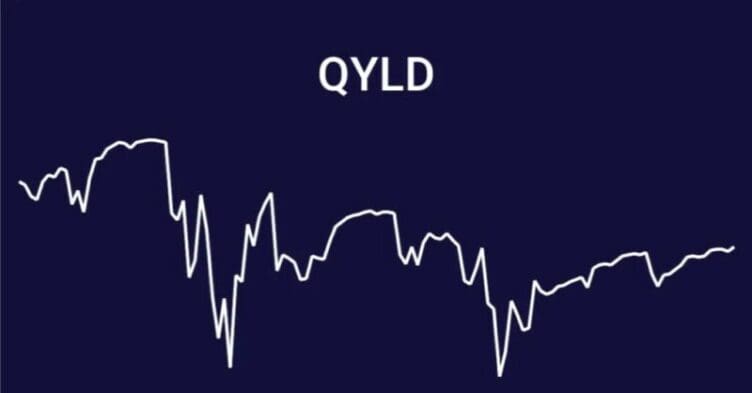Global X NASDAQ 100 Covered Call (QYLD) ETF is a well known income-oriented investment option. While QYLD’s high distribution yield and NASDAQ 100 tracking strategy might seem promising, there’s more beneath the surface. From concentration risks in tech-heavy stocks to potential tax implications, we take a look at the nuances of QYLD, so you can decide if it’s right for you. Is QYLD a good investment? Whether you’re seeking consistent income, capital appreciation, or both, understanding the full picture is crucial.
Concentration Risk in the NASDAQ 100
QYLD’s investment strategy revolves around tracking the NASDAQ 100 index while engaging in covered call options. While this approach aims to generate income, it also exposes you to concentration risk. The NASDAQ 100 is heavily composed of large-cap growth tech stocks, which have shown strong performance in recent years. However, it’s important to consider that these stocks are currently trading at historically high valuations.
You should be cautious about the concentration risk associated with QYLD’s heavy reliance on the NASDAQ 100. Although large-cap growth stocks have delivered impressive returns, they may face challenges in sustaining their growth rates. Market conditions can change rapidly, and a shift in investor sentiment towards value or other sectors can lead to a decline in the performance of tech-heavy indexes. If a significant market correction occurs, QYLD may experience higher volatility and potentially lower returns, making it a less attractive long-term investment option.
Moreover, the valuation spread between growth and value stocks is at unprecedented levels, suggesting potential lower future returns for large-cap growth stocks. This further adds to the concern over concentration risk in QYLD. Diversification is an essential aspect of any investment strategy, as it helps to mitigate risk. By investing solely in the NASDAQ 100, QYLD lacks the diversification benefits that a broader-based ETF or mutual fund can provide. Therefore, if you’re seeking a well-diversified portfolio you may find other investment options more suitable for their long-term financial objectives.
Limited Capital Appreciation Potential
While QYLD offers an attractive distribution yield, it’s essential to consider its impact on capital appreciation potential. The fund’s strategy of selling covered calls places a cap on price appreciation. Covered calls involve selling call options on the underlying stocks held by the fund. In exchange for selling these options, the fund receives premium income. However, by engaging in this strategy, QYLD limits its potential gains when the underlying stocks experience significant price increases.
During bullish market conditions, when the underlying stocks in the NASDAQ 100 rally, QYLD may underperform the broader market. While you will benefit from the regular income generated by the covered call strategy, you may miss out on significant price appreciation. This limitation can be a drawback if you’re seeking both income and capital appreciation. You may prefer alternative investment options that provide exposure to potential gains in the underlying stocks without those restrictions.
You should carefully assess your investment objectives and time horizon when considering QYLD. If long-term capital appreciation is a priority, it may be worth exploring alternative investment strategies or diversified ETFs that offer a broader exposure to the market. By considering investment options that align with your goals, you can optimize their portfolio for both income and capital appreciation potential.
Fluctuating Performance and Drawdowns
When assessing the performance of any investment, it’s crucial to look beyond its distribution yield. While QYLD provides income through its covered call strategy, its capital appreciation component has been relatively flat on average and even negative since its inception. Comparing QYLD to the underlying NASDAQ 100 index (QQQ), we can observe that QQQ has delivered higher risk-adjusted returns over the long term.
Additionally, QYLD has experienced significant drawdowns during periods of market volatility. For example, during the market downturn in March 2020 due to the COVID-19 pandemic, QYLD’s price declined more than the broader market indexes, reflecting its sensitivity to market fluctuations. Such drawdowns can be unsettling, especially if you’re relying on stable income generation.
While past performance does not guarantee future results, you should carefully consider the historical performance of QYLD and evaluate whether its return profile aligns with your risk tolerance and investment objectives. For your looking for stability and consistent long-term returns, other investment options with proven track records may provide a more suitable choice.
Potential Tax Implications
Be aware of the potential tax implications associated with QYLD’s distribution yield. The income generated through QYLD’s covered call strategy is treated as ordinary income for tax purposes. This means that you may be subject to higher tax rates compared to qualified dividends or long-term capital gains.
Furthermore, the timing of the distributions can impact tax liability. QYLD distributes income on a monthly basis, which may result in taxable events for you if you hold the fund in taxable accounts. The regular distributions can create a tax burden, especially if you’re in a higher tax bracket.
You should consult with tax professionals to understand the tax implications of investing in QYLD and how it aligns with your overall tax planning strategies. Depending on individual circumstances and tax objectives, you may find alternative investment options that offer more tax-efficient income generation or capital gains treatment.
Availability of Better Investment Alternatives
Lastly, you should consider the availability of other investment alternatives that may offer more attractive risk-reward profiles compared to QYLD. The ETF market provides a wide range of choices, allowing you to tailor your portfolio to your specific needs and preferences.
If you’re seeking income generation with a lower concentration risk, there are dividend-focused ETFs that offer exposure to a diversified basket of stocks with a history of consistent dividend payments. These ETFs may provide a more balanced approach to income generation without the limitations associated with covered call strategies.
Similarly, if you’re seeking broad market exposure with potential for capital appreciation, diversified ETFs that track well-established market indexes, such as the S&P 500, may be more suitable. These indexes typically comprise a broader range of sectors and offer a more balanced representation of the overall market.
Is QYLD a Good Investment? While QYLD may initially seem appealing due to its high distribution yield and income-generating strategy, you should carefully evaluate its suitability against your investment goals. The concentration risk in the NASDAQ 100, limited capital appreciation potential, fluctuating performance, potential tax implications, and the availability of better investment alternatives are all crucial factors to consider. Conducting thorough research, assessing risk tolerance, and consulting with financial professionals are essential steps to make informed investment decisions aligned with individual circumstances. By evaluating these factors, you can navigate the investment landscape more effectively and build portfolios that align with your long-term goals.



